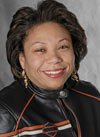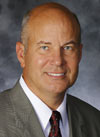 Wisconsin Lawyer
Wisconsin Lawyer
Vol. 80, No. 9, September 2007
 ndre Wright, a Harlem, New York native, enrolled in the University of Wisconsin Law School in 1998, figuring it was an excellent school and that he'd get to see a different part of the country for three years. "Back then I didn't think about staying in Wisconsin," he says.
ndre Wright, a Harlem, New York native, enrolled in the University of Wisconsin Law School in 1998, figuring it was an excellent school and that he'd get to see a different part of the country for three years. "Back then I didn't think about staying in Wisconsin," he says.

"Most [classmates of color] wanted to go to larger, more diverse cities. I think they questioned the opportunities available to them here in Wisconsin."
-Andre Wright, U.W. 2001, Whyte Hirschboeck Dudek, Milwaukee
After graduation, Wright decided to stay after all, which was surprising, he admits. "There are still days when I wake up and think, `I'm in Wisconsin.'" He's practiced law at Whyte Hirschboeck Dudek S.C. in Milwaukee since 2001, and he's now a member of the State Bar of Wisconsin's Diversity Outreach Committee.
Among his fellow classmates of color, however, more opted to leave the state than to stay to practice law. "Most wanted to go to larger, more diverse cities," Wright says. "I think they questioned the opportunities available to them here in Wisconsin."
The outflow of law students of color continues today. Of the 270 U.W. Law School graduates from December 2005 through August 2006, 74 were students of color. Among those, of the 60 who reported where they'd found work, 60 percent said they were leaving Wisconsin. That figure compares to 45 percent of the entire graduating class (Caucasian and students of color combined) who left the state for their first jobs, according to law school estimates.
At Marquette University Law School, the class of 2006 included a total of 232 students, 16 of whom were students of color. Of those, 44 percent left the state for employment, compared to a rate of 24 percent for the entire class.
Lia Moeser, a 2007 U.W. Law School graduate and a native of Glendale, chose to take a job at Whyte Hirschboeck Dudek in Milwaukee, even though she'd earlier assumed she'd head to a bigger city. But she knows many other students of color in her class who decided to leave the state.
"I think the consensus among students [of color] is that the law school is so supportive, but the law firms aren't like that," she says. "They think that Wisconsin in general is not like the law school."

"When it comes to building clientele and bringing business into the firm, it's the stylistic aspects that are important. Those are things people don't generally talk about in mentoring because they're hard things to talk about."
-Tonit Calaway, Chicago 1992, Harley-Davidson Motor Co., Milwaukee
Many law firms, corporations, and other legal employers are striving to change that perception and boost Wisconsin's appeal as a place for lawyers of color to practice.
"There's been an increase in the number of law firms and employers who are sincerely searching for ways to recruit and retain minority attorneys," says Bruce Lindl, corporate counsel at Regal Ware, Kewaskum, and immediate past chair of the State Bar's Diversity Outreach Committee. "I say `sincerely' because they're not just doing this for the sake of doing it. There's a recognition of the value of diversity."
Benefits All Around
One goal of diversity is to make law firms more reflective of the communities they're in. Corporations also strive for their organizations to be more diverse, because they serve an increasingly diverse consumer marketplace. And corporations are asking, often requiring, that the law firms they hire bring diverse faces to the table, as well.
Diversity is vital in the criminal justice arena, too, says Lovell Johnson, a Milwaukee County deputy district attorney. Now in his 21st year in the DA's office, Johnson notes that former district attorney E. Michael McCann made diversity a top priority in the department, as has his successor John Chisholm.
"The criminal justice system can't just be fair, it has to appear fair," Johnson points out. "We have to be representative of those coming through the system, which, for whatever reason, is heavily populated with minorities, both as defendants and victims."
The presence of lawyers of color in the courtroom also sends another important message, Johnson points out. "When young defendants sit in court and see a prosecutor, defense attorney, or judge who looks like them," he says, "it can enter their minds that they could do better. We can serve as examples in our community."

"There's been an increase in the number of law firms and employers who are sincerely searching for ways to recruit and retain minority attorneys."
-Bruce Lindle, U.W. 1972, past chair, Diversity Outreach Committee
Whatever the legal practice setting may be, diversity brings varied perspectives, experiences, and ideas to the problem-solving process. Leticia Smith-Evans, a New York City lawyer and member of the Bar's Diversity Outreach Committee, emphasizes that many factors go into diversity.
"As a lawyer of color, I need to feel that my diversity, in all senses of the word, is respected and appreciated," she says. "That includes my educational background and professional experiences, as well as my race."
For firms and other legal employers who want to increase their diversity, "it's no longer acceptable to just have a diversity director or committee, if it's in name only," Smith-Evans says. "If you're doing things to actively address the issue, that's great. That's a start."
Diverse to the Core
Moving toward greater diversity begins by acknowledging that differences do exist and that people bring those differences to their jobs, professions, and experiences, according to Teveia Barnes, a partner at Foley & Lardner LLP who works in the firm's San Francisco office. "You can't take as a given that your way of looking at something will be the same as another person's," she says.
Recognition of that factor is the first step in what Barnes describes as "managing diversity as a core value." By "core value," she means that diversity is woven right into how a firm or company operates. "It's innate," she explains. "When you're presented with an issue, everyone knows the right thing to do, without having to look it up in a policy manual."
She relates as an example an incident she experienced in her career years ago while working as a corporate attorney. A client made a sexist remark during negotiations, and she tactfully told him not to speak to her that way. Fearing she might have lost a client, she immediately told her superiors what had happened.

"You can start to change the culture [of law firms] by taking away some of the partners' subjectivity and forcing them to be more objective about choosing from the pool of talent available to them."
-Arin Reeves, diversity consultant and lawyer. Athens Group, Chicago
"They said, `Don't worry about it. We'll support you. The guy was wrong, and if that's the kind of person he is, we don't want to do business with him,'" Barnes recalls. "It wasn't as though anybody had to stop and say, `We'll get back to you when we figure out what to do.'"
Adopting diversity as a core value means more than letting attorneys of color through the door, Barnes emphasizes. There also has to be a genuine effort to provide what those attorneys need to succeed. That's the key to the companion to recruitment: retention.
"If people leave, you have to be honest and candid about why they left," Barnes advises. "Did you create an environment where they could do their best work, or did you treat them as cogs? Did you introduce them to all clients as appropriate, or only to the clients who have diversity initiatives? Did you invite them into your homes and make them feel part of the community?"
For Moeser, it was the environment she discovered at Whyte Hirschboeck Dudek that swayed her decision to stay in Wisconsin to practice law. She'd done a summer internship at the firm after graduating from Northwestern University, and then spent two summers during law school in a clerkship. Not only did she get a chance to polish her legal skills, but the firm's attorneys also accompanied her to such events as community organizations' board meetings and Bar functions. "They were willing to invest in me," Moeser says. "They wanted me to flourish."
Stop to Think
Creating a diverse legal profession is about more than providing equal opportunities, says Arin Reeves, a lawyer and diversity consultant with the Athens Group, Chicago. It also requires making changes in law firm culture. "I think a lot of law firms do the first part," she says. "It's the second part that's often missing."
How does a firm go about changing its culture? In both minor and major ways, Reeves says. Some of the little things include where you hold your social events, what kind of food you order for lunch meetings, the race and gender of speakers you bring in, and the holidays you celebrate. Even the art on your walls sends a message, Reeves contends.
"When people walk in the door, do they see pictures of dead white guys, and that's it?" she asks. "I've had lawyers say, `I look at pictures of those guys and know that if they were alive today, they wouldn't hire me.'"
Among the bigger issues in the firm's culture are such matters as how the firm makes work assignments. Do partners have total control over whom they choose to work with on projects? Reeves points out that 85 percent of law firm partners nationwide are white males. Left to their own preferences, they're likely to pick young white male associates to work with them, just because it's the easiest, most comfortable choice for them to make.
"You can start to change the culture," Reeves advises, "by taking away some of the partners' subjectivity and forcing them to be more objective about choosing from the pool of talent available to them."
Similarly, old habits and assumptions can influence what kind of client exposure associates get. Don't just leave it up to the partners to decide who's going to dinner with a client. Instead, Reeves suggests having a larger discussion in the firm to consider all associates who ought to be involved in the dinner.
By paying attention to these and other choices made every day, a firm creates a culture that's more inclusive. "It takes thinking more creatively," Reeves contends, "and just stopping to think. If you're saying you want differences, think about what you have to do differently."
Willingness to Pave the Way
A key element in an inclusive culture is mentoring, says Tonit Calaway, associate general counsel for Harley-Davidson Motor Co., Milwaukee. She likes to phrase it in terms of "true mentoring," which goes beyond the technical aspects, such as editing a young lawyer's legal memo, to include being a "stylistic advisor," she says.
"When it comes to building clientele and bringing business into the firm, it's the stylistic aspects that are important," Calaway says. "How do you approach talking to clients? What are you wearing? How do you win client confidence? Those are things people don't generally talk about in mentoring because they're hard things to talk about."
Calaway says she's been lucky to have great mentors from the beginning of her career (at Godfrey & Kahn S.C. in 1992 in Milwaukee) right through to her tenure at Harley-Davidson, where she's been for nine years.
All her mentors have been Caucasian, while Calaway is African-American. Although racial matches can be helpful in mentoring for lawyers of color, she contends, "I don't think it's important." For instance, her two chief mentors now at Harley-Davidson are Gail Lione and Ed Krishok. What matters is that when it comes to knowing how to mentor, "they absolutely get it," Calaway says. "They also get me."
But Calaway and others interviewed for this article acknowledge that a Wisconsin law firm or other employer can strive for a genuinely inclusive climate and still not succeed in attracting and retaining lawyers of color. Many law school graduates simply prefer to get jobs in cities where the community and the legal profession as a whole outshine Wisconsin in diversity.
As Barnes notes, "Students of color coming out of law schools today don't necessarily want to be trailblazers. They want to focus on their craft and become exceptional lawyers."
Calaway has little patience with that outlook on the part of young lawyers. When she hears them say they'd rather leave Wisconsin to work in a city and firm where they'll see more people who look like them, "I call them on it," she says. "It's a copout."
In Calaway's view, it takes efforts by both law firms and lawyers of color to build diversity in Wisconsin's legal profession. She argues that lawyers of color must be part of the solution, even if they sometimes feel uncomfortable.
"Whatever we experience today is nothing like what those before us experienced," Calaway says. "Vel Phillips was doing her thing in Milwaukee in the 1960s. You have John Daniels, Richard Porter, the firm of African American lawyers at Wilson, Broadnax & Owens who have practiced for some 40 years in Milwaukee. All those people made it easier for us. Not only do we owe a debt to the people before us, we owe a debt to the people coming after us."
Reaching Out
Recruiting law school graduates of color to practice in Wisconsin is vital to building diversity. And building relationships with students while they're in law school helps.
One such effort is the State Bar's Minority Clerkship Program (see the accompanying sidebar "Taste of Wisconsin Law"). Another is the U.W. Law School's Friends of LEO (Legal Education Opportunities) Mentoring Program, which provides mentors for first-year students of color, as well as some other students. "Among the stated goals is to help develop a diverse Wisconsin legal community," says Carolyn Lazar Butler, assistant dean for external communications at the law school.
Reeves suggests that employers also throw a broader net when hiring, beyond current law school graduates. For starters, focus on those who took out-of-state jobs a few years ago, she says.
"They might consider you when they're in their third year and they're being chewed up and spit out by a big New York City firm," she notes. Also, she recommends tracking Wisconsin residents who left to attend law school elsewhere and eventually may want to return to their home state.
Firms and other employers "spend time agonizing over why law students are leaving for Chicago, or D.C., or New York," Reeves points out. "But they don't spend enough time on how you get them back a few years later."
A common mistake Reeves notices in efforts to recruit lawyers of color is to try to compete with the large, big-city firms on their terms. For instance, she sees Wisconsin firms going to the same job fairs as the big firms or "trying to glossy up their brochures," she says.
A better strategy would be to "recruit along the lines of why you're different," Reeves says. "I think firms in Wisconsin need to focus more on communicating why they would be a firm of choice" for a job-seeker.
Another tactic she suggests is for law firms and other employers to launch collective efforts to reach out to law students of color. An example is the Twin Cities Diversity in Practice initiative in Minnesota (www.diversityinpractice.org). Nineteen law firms and 11 corporate legal departments have teamed together to attract, recruit, advance, and retain attorneys of color in the Twin Cities legal community. Among other efforts, the so-called "flying squads" include attorneys who travel to law schools around the country to share their perspectives on what it's like to live and practice law in the Twin Cities.
Whatever strategies employers adopt, bear in mind that building diversity takes a long-term approach, Reeves points out. Resist the urge to give up too soon. "Employers often try something and a year later, they're no more diverse," Reeves says. "They think that must mean what they're doing isn't working. I suggest looking at this from at least a five-year or 10-year perspective."
Andre Wright, the Harlem native and U.W. Law School graduate who surprised himself by staying in Wisconsin to practice, echoes Reeves' sentiments. Building diversity takes a sustained effort and doesn't trigger immediate results. By no means is diversity an easy task, he notes.
"But it's one we must and can achieve," he says. "I think it is possible. I mean, I'm here. I'm sure there are others who could be here, as well."
Wisconsin Lawyer
